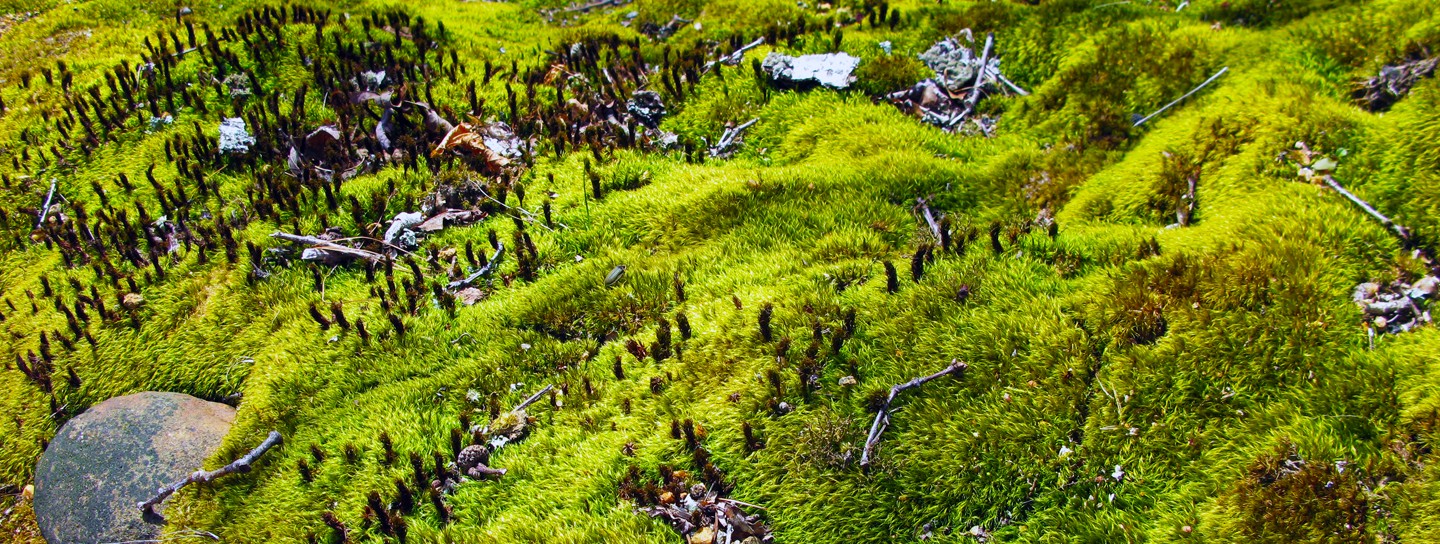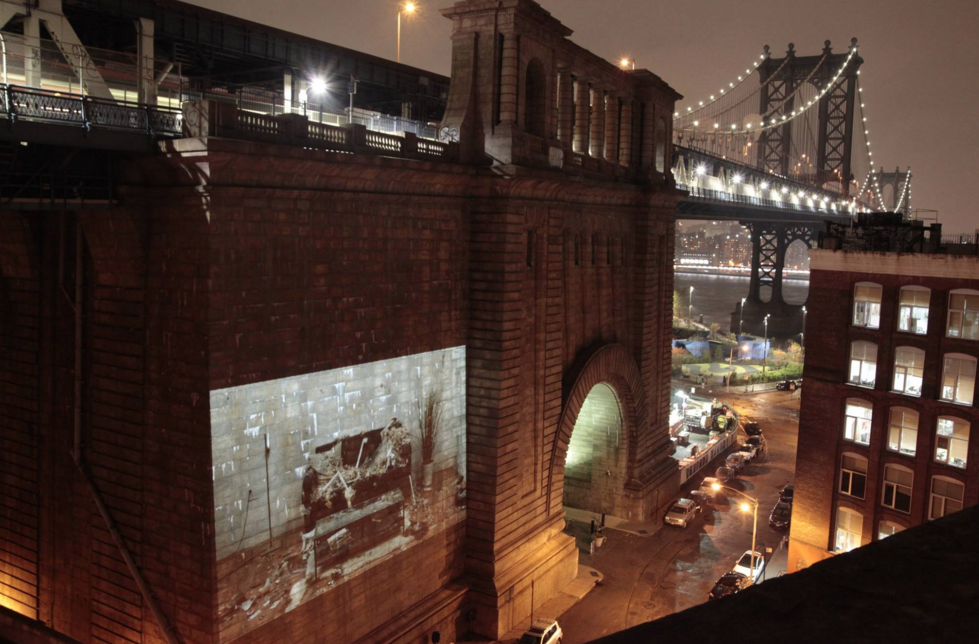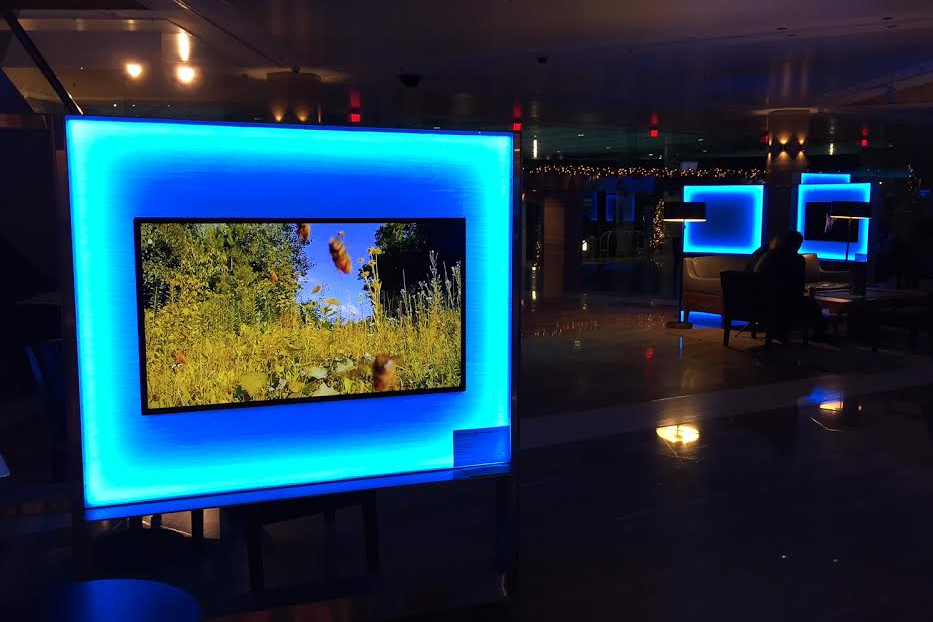“Decomposing Hierarchies”
Curated by Sarah Walko, Director of Arts Programming, Marble House Project
This exhibition took place on Thursday, November 5th, 2015 on the Manhattan Bridge Anchorage and was also presented December 2nd-6th 2015 in Miami Florida within the Form and Substance exhibition.
Works by Marble House Project 2015 Residents: Anne Katrine-Senstad, Catherine Page Harris, Orit Ben-Shitrit, Margeaux Walter, and Jeannette Ehlers.
“Decomposing Hierarchies” is a publicly-presented video art exhibition on the Manhattan Bridge anchorage that explores various approaches to striping systemic hierarchies. The descriptive “decomposing” is chosen as each of the artists is pulling us through a transformation. Whether between living species, value systems or race, all of these artists are examining our relationship with historically and culturally constructed pecking orders that are in a state of decay and are far past serving us as a culture.
All of the artists in this exhibition were residents of Marble House Project in 2015, a non-profit arts organization that focuses on the arts and sustainable agriculture. Marble House Project nurtures the imaginative spirit. Through artist residencies, workshops and sustainable agriculture, Marble House Project promotes an innovative atmosphere and exchange of ideas. Inspiration, contemplation and creativity are the hallmarks of the program. The project focuses on conservation of natural resources, integration of small-scale organic food production and the arts. Residents sustain their growth by cultivating and participating in the surrounding grounds, working on their artistic vision and forging partnerships within the community. Marble House Project is founded on the belief that the act of creating, whether through art or in nature is where human potential begins and community thrives. Marble House Project is a 501(c)(3) organization founded in 2013 and is located in Dorset, Vermont.
About “Light Year”
The Manhattan Bridge comes alive with “Light Year,” a one-year program of projected video art presented the First Thursday of every month. In honor of the United Nations’ declaration of 2015 as The Year of Light and Light Art, “Light Year” includes a well-rounded program of video artists from around the globe. Curated, created and presented by Leo Kuelbs Collection, John Ensor Parker and Glowing Bulbs (aka 3_Search), “Light Year” reveals surprising connections and highlights Dumbo’s role as an important hub for technology and the arts.
Works:
The Swamp by Anne Senstad, 2014, 3.45 min, Score by JG Thirlwell
Presented as part of Senstad’s solo show The Vanity of Vanities at El Magazen dell’Arte during the 56th Venice Biennale and Safina Project, also during the 56th Venice Biennale, a Collaterali Eventi United Arab Emirates project organized by Al Serkal Avenue in Dubai and was part of the exhibition The Nature of Now, a satellite of Prospect 3, New Orleans Biennial 2014.
The Swamp is an homage to and a lyrical meditation on the culture, history, nature and anthropological complexities of the American south, where the swamp itself is the symbolic protagonist. Filmed in the swamps outside Baton Rouge in Louisiana, the video evokes the mystique, beauty and darkness of the swamps and the Mississippi delta. The swamp undermines the boundaries between death and life by asserting their tandem—and sometimes weirdly beautiful—coexistence, and opens up an unsettling space for a contemplation of lively death. Historically and psychologically the swamps of Louisiana represent a place of freedom. Slaves who managed to escape cotton and sugarcane plantations would hide and later establish communities, people known as Maroons; – the white colonial man feared enter. The Acadians displaced from French Canada would create settlements in the swamps, as did Native Americans such as the Choctaw, mixing blood with the Acadians and former slaves. A creation of new cultures developed which became the French creole, the Cajun and the Mardi Gras Indians. The sound of the Swamp is colored by amalgamation of blood and culture and the stories of death and hardship found in the Mississippi delta blues, old slave songs that carried on to be sung in prisons of the south, early Gospel, spirituals and the Cajun Zydeco music. The Mississippi Delta blues sound narrates the slow moving water, the heat and insects played on a haunting guitar with vocals of suffering, love, hate, freedom, religion and poverty.
Ecologically, Swamps are transitional areas. They are neither land nor water. Swamps are actually among the most valuable ecosystems on Earth. They act like large sponges and reservoirs. As heavy rains cause flooding, swamps and other wetlands absorb excess water, moderating the effects of flooding. Swamps also protect coastal areas from storm surges that can wash away fragile coastline like the fast eroding coast and wetlands of Louisiana. Saltwater swamps and tidal salt marshes help anchor coastal soil and sand.
Black Bullets by Jeannette Ehlers, 2012, 4:33 min, Sound: Trevor Mathison, Technical assistance: Markus von Platen, Camera: Jette Ellgaard & Jeannette Ehlers
Jeannette Ehlers’ haunting and meditative piece “Black Bullets” is inspired by the Haitian Revolution of 1791 that resulted in the world’s first black republic. Filmed on location at La Citadelle in Haiti, the piece is a tribute to the act of revolt. Liberty, equality and fraternity echoed from the streets of Paris across the Atlantic to the African slaves in the French colony of Saint-Domingue (Haiti), which was the first Latin American country to gain independence as a result of the only successful slave revolt in history. Black Bullets was recorded at a mountaintop citadel in Haiti, the largest in the Americas and built after the rebellion as a defensive measure for the new state. To this day, the citadel stands as a symbol of the emancipation. A series of black figures move in a looping sequence across the silvery sky to the pulse of a heavy, hypnotic drone-like sound, united with their reflected images, merging with them, almost like bullets gradually being cast. Jeannette Ehlers is based in Copenhagen, Denmark. A 2006 graduate of The Royal Danish Academy of Fine Arts, Ehlers’ works revolve around the Danish slave trade in the colonial era.
Onomono by Orit Ben-Shitrit, 2014, 5 min
ONOMONO is an experimental video projection that combines found archival footage composited with imagery shot by the artist. The original soundtrack was created by Ben-Shitrit in collaboration with Timothy Korn, using live-feed into a Kaleidoloop. The video was created in collaboration with editor Jeremy C. Hansen.
ONOMONO depicts a circle of destruction. The video captures the ailments of our society using archival footage ghosted over original footage of the Atlantic-ocean, Cappadocia, and a dilapidated British Colonialist-era post in the Arab-Israeli town of Abu-Ghosh. The archival material includes depression-era economic graphics, as well as catatonic masked Schizophrenia and OCD patients.
The word ONOMONO is a palindrome—it can be read forward and back. The video begins and ends with the same visual note. The sound is created using live-feed into a Kaleidoloop—a digital recording device that can layer both live and pre-recorded sounds, while navigating and altering playback speed and direction.
This work was inspired by the French Anarchist book the Coming Insurrection, which offers a vivid diagnosis of the capitalist decrepitude of our society.
Act of God by Margeaux Walter, 2014, 3:03min
In Act of God, a 3-minute stop motion video, shows a destroyed room being put back together into an Ikea style showroom. Through a series of 1200 stop-motion photographs, the room is built, destroyed and recreated. This piece explores America’s relationship to disaster as mediated through commerce and the news. Time and order are both turned upside-down mirroring how the news disorients events, creating a new history. As the room gets pieced back together, the values of the objects within the space are broken down and reassigned. Siri narrates the progression through a series of real estate euphemisms, further emphasizing the artifice that many cling to in everyday life.
Trans-species Repast: At the Same Table by Catherine Page-Harris, 2015, 4 min
Trans-species Repast directly examines the assumptions of hierarchy in our relationship to landscape. Trans-species Repast Family Dinner is artist Catherine Page Harris’ metaphor to understand all biotic life as being at the same table on our planet. Harris’s deceptively simple gesture of sharing family dinners with animals questions complex systems of exploitation, resource extraction, and dominance. The human species has generally viewed itself in a hierarchical relationship to all species and resources on the planet.
The difference Trans-species Repast Family Dinner hopes to make is to engage animals and humans at the same table to share a meal together. The dinner extends the warmth and conversation of family dinner to the entire planet, one meal at a time. Harris offers this action to shift the dominant hierarchical paradigm and portray that we are at the same table and we have to all interact together at that table. Human and animal share the resources of the planet. Climate change, extreme weather, sea level rise are all symptoms of humanity imagining the planet’s table is set just for us.



